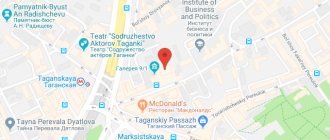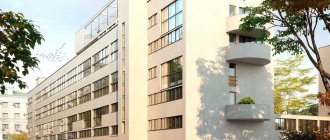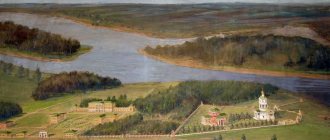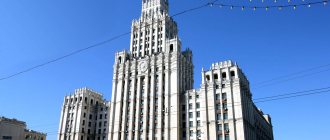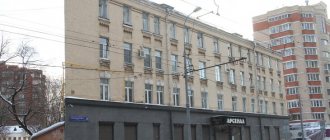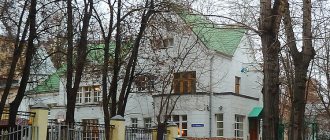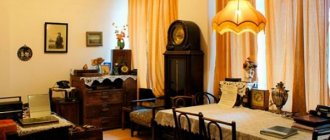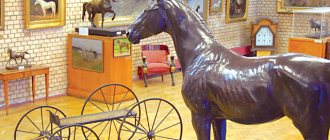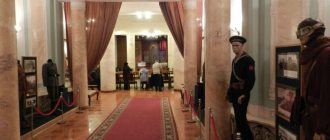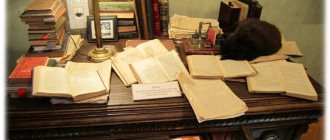Moscow has more than once become a source of inspiration for famous Russian writers and poets. Many of them had the opportunity to live in Moscow for a long time, and some were even born here. No matter how long ago it was, now everyone can go through the house-museums of famous writers and look at Moscow through their eyes. Our selection will tell you where to go for this.
Moscow! – What a huge Hospice House! Everyone in Rus' is homeless. We will all come to you.
And hallelujah pours over the dark fields. I kiss your chest, Moscow land! M. Tsvetaeva
Pashkov's house on Vozdvizhenka
The legendary Pashkov House, one of the most beautiful architectural monuments in the capital and a universally recognized symbol of Moscow. This majestic building, rising on Vagankovsky Hill, at the intersection of Mokhovaya Street and Znamenka, is known to every Muscovite.
Interesting house museums in Moscow – Pashkov House
The Pashkov House Museum got its name in honor of the first owner, retired officer Pyotr Pashkov. It was by his order that this fabulous mansion was built in the 60s of the 18th century. It is believed that from the belvedere of this building, the heroes of Bulgakov’s novel “The Master and Margarita” Woland and Azazello looked at the city and said goodbye to it, leaving it forever.
Pashkov's mansion on Vozdvizhenka consists of a central building and two wings, which were added later. The main entrance to it is located from Starovagankovsky Lane, and the front facade faces Mokhovaya and faces Borodinsky Hill and the Kremlin.
The building of the house-museum with its porticoes, elegant decorations, columns and skyward belvedere is perceived as a monumental sculpture placed on a kind of pedestal.
Address : Moscow, st. Vozdvizhenka, 3/5, building 1
Metro : station "Borovitskaya", "Library named after. V.I. Lenin", "Alexandrovsky Garden".
Website : https://www.rsl.ru/ru/events/halls/dom-pashkova
Telephone: +7 (499) 557–04-70; +7 (499) 557–04-72.
Operating mode:
- Monday – Saturday from 9:00 to 20:00;
- Sunday is a day off.
In the 18th century, the famous German traveler Richter called Pashkov's house a magical castle. This definition fully corresponds to the appearance of an ancient city estate. The fairy-tale mansion seems light and airy, as if it came from a dream world.
The amazing Pashkov house-museum has been attracting both tourists and Muscovites for almost two centuries. A unique mansion, which has withstood various changes and more than one restoration, has survived many rulers, rises on a hill in the very center of Moscow as a symbol of eternity and beauty that conquers time.
Parsnips and spring water
Village DSK "Michurinets", Pavlenko street, 3
More about the house-museum of Boris Pasternak
Once in Peredelkino, first of all make a pilgrimage to the house of Boris Pasternak on Serafimovich Street. The wooden building with a rounded facade has not changed its appearance since its construction. This is the writer’s second house in Peredelkino; he lived and worked here from 1939 to 1960. If you are lucky and the house museum is open, take a tour: they talk about secret correspondence with Tsvetaeva and Rilke, friendship with Neuhaus and the family’s struggle to preserve the house.
Up the street, after 200 meters, there is a spring. Pasternak loved to spend time there, and you can get some water for a walk and read one of the poems from the Peredelkino series.
House of Scientists on Prechistenka
The building of the House of Scientists was completely rebuilt in the neoclassical style with Art Nouveau elements from the previous building at the end of the 19th - beginning of the 20th centuries by architect Anatoly Gunst for the widow of a major Russian industrialist I. N. Konshin.
The Central House of Scientists was created in 1922 on Prechistenka not by chance - in this area there are many scientific institutes, higher educational institutions, institutes of the Academy of Sciences, the Academy of Arts, humanities faculties of Moscow University, the Russian State Library and a number of museums.
In the House-Museum, long-forgotten but wonderful forms of creative work and good traditions laid down by our predecessors began to be revived. Thanks to the team of employees and the care of the Russian Academy of Sciences, it was possible to preserve the unique spirit of old intelligent Moscow, the spirit of creativity.
Famous theater groups regularly come here on tour, they hold musical and creative meetings with famous writers, scientists, artists, evenings of old romance, and performances by soloists of musical theaters.
Address : Moscow, st. Prechistenka 16.
Metro : station "Kropotkinskaya".
Website : https://www.cdu-art.ru
Telephone: +7 (495) 637–45-55.
Operating mode:
- Monday – Saturday from 12:00 to 22:00;
- Sunday is a day off.
In the building of the Central House-Museum of Scientists there is a large concert hall with 500 seats, a chamber concert hall with 90 seats, a blue living room for meetings and presentations, a Green living room for meetings of scientific sections, as well as a billiard room, a restaurant, a buffet and a cafe.
How to prepare
Listen to the episode of the “Radio Travelers Club” program on Mayak radio, dedicated to Peredelkin. Historian Marat Safarov talks “about the literary and political history of the most elite suburban housing before and after the war.”
Read an interview with the creative director of the Writers' House of Creativity - about the abandoned 2000s, reconstruction and the mythology of space.
View a map with all the sights of Peredelkino.
Museum "House on the Embankment" on Serafimovicha
The building was built in 1928 in the style of late constructivism by the architect B. Iofan. The House on the Embankment Museum was created here on November 12, 1989, on the initiative of one of the oldest residents, T. Ter-Yeghiazaryan. Since 1997, the building has been a historical monument and is protected by the state.
Since mid-1998, the complex on Serafimovicha was reorganized into the Municipal Museum of Local Lore of the Department of Culture of the Central Administrative District of Moscow. The director was Olga Trifonova, a writer, the widow of the Soviet writer Yuri Trifonov, author of the story “The House on the Embankment.”
Over the course of 20 years, museum staff collected a large amount of material about the history of the house and its inhabitants, including documents, photographs, personal belongings, books and interior items. Thousands of visitors visited the museum.
This is the only House museum in the country and one of the few in the world. Politicians, military leaders, famous artists, writers and scientists lived and still live in it.
Address : Moscow, st. Serafimovicha, 2.
Metro : station “Kropotkinskaya”, “Polyanka”.
Website : https://dnnmuseum.ru
Telephone: +7 495 959–49-36.
Operating mode:
- Tue, Wed, Fri 10:00 – 18:30;
- Thu 11:00 - 21:00;
- Sat, Sun 11:00 – 18:00;
- Monday is a day off.
A small but very educational house-museum. The furnishings of the apartment of the Soviet intelligentsia of the 1930s are recreated here, and authentic furniture created according to the sketches of the chief architect is presented. By the way, this place is part of the Gulag Museum , which impressed me very much.
#7. Mayakovsky's dacha on Shark Mountain
Address: Moscow region, Pushkino, Akulova Gora, Akulova Gora microdistrict, 7
Mayakovsky's dacha on Shark Mountain
The very place where “the hillock of Pushkino humped Shark Mountain.” V. Mayakovsky came to this dacha for several years and wrote many poems and poems here. Then for a long time the building was used as a library. In 1991, there was a terrible fire and the building was badly damaged. But in 2014, after a long and difficult reconstruction, initiated by local priest Andrei Dudarev, the dacha-museum was opened to visitors. Restoration work and replenishment of the exhibition continues. At the moment, among the interesting exhibits in the museum you can see Mayakovsky’s death mask, his copper samovar, as well as portraits and homemade sculptures.
Pushkin Apartment Museum
Memorial apartment A.S. Pushkin on Arbat is the only museumized memorial of the great Russian poet in Moscow. The building is included in the list of cultural monuments of national significance.
January 23, 1831 A.S. Pushkin entered into an agreement to rent an apartment in a mansion on Arbat, which belonged to the noble family of Khitrovo. On February 17, 1831, on the eve of the wedding, his Moscow friends gathered for the poet’s “bachelor party.” The poet brought his young wife here after the wedding. The first months of the Pushkins’ happy family life passed here.
On February 18, 1986, on the day of the 155th wedding anniversary of A.S. Pushkin and N.N. Goncharova, the grand opening of the Pushkin museum-apartment took place. On February 18, 1999, after restoration, the Memorial Apartment on Arbat again opened its doors to visitors.
The exhibition space of the museum occupies two floors of the mansion. The first one houses the permanent exhibition “Pushkin and Moscow”, and the second one houses the family’s memorial rooms. Despite the fact that the authentic furniture has not been preserved, the interiors of the rooms were restored according to the memories of Pavel Vyazemsky, who often visited the family.
Address : Moscow, st. Arbat, 53.
Metro : station "Smolenskaya", "Arbatskaya".
Website : https://www.pushkinmuseum.ru
Telephone: +7 495 637–56-74.
Operating mode:
- Tue-Sat 10:00 – 18:00;
- Monday is a day off.
The happy days that flew by in the cozy museum-apartment on Arbat cemented the feelings of the young people, which most fatally affected the fate of the greatest Russian genius Alexander Pushkin and his charming wife Natalya Goncharova.
The young couple lived in the house on Old Arbat for three months, but this was enough for their admiring descendants to come here again and again to honor the memory of the great poet and his beautiful beloved.
Visiting Dostoevsky
Let's start with Fyodor Mikhailovich Dostoevsky .
An important digression: the classic did not have his own house. Apparently, the writer’s passion for gambling, the writer’s irregular income, and the then widespread phenomenon of living in rented apartments made him a nomad. Dostoevsky and his family lived in so-called apartment buildings (80% of the development in the center of St. Petersburg are houses built for rent). Moreover, he always rented housing from the same owner and certainly close to the church. Fyodor Mikhailovich loved the ringing of bells. His last home and long-term refuge was an apartment in Kuznechny Lane, 5/2. Use your imagination and imagine yourself at the beginning of the 19th century, as soon as you leave the Vladimirskaya or Dostoevskaya metro stations. Walk along the narrow alley past the Vladimir Cathedral on the left and the ancient Candle Market on the right (in the photo above there is a bright two-story building on the right), and literally in 50 meters you will find yourself at the desired house.
They tried to preserve all the evidence of that time in the apartment; in the interior there are many original things that belonged to the writer. We wrote more about the museum-apartment writers here. By the way, the term “Dostoevsky’s Petersburg” refers not so much to this area as to the Admiralteysky located next door. It was the houses near today’s Sadovaya/Sennaya/Spasskaya metro stations that inspired the writer to write “Crime and Punishment.” To look at the houses of Raskolnikov, Sonya, the old pawnbroker and other heroes, sign up for a thematic tour (click here).
You can order a tour of Dostoevsky’s apartment by calling: 571 40 31. The cost for a group of up to 20 people is 800 rubles, plus 100 rubles per visitor for entry.
Bulgakov Apartment Museum
The bad apartment number 50, known from the novel “The Master and Margarita,” in which Woland lived, has its own prototype. This is the apartment of Mikhail Bulgakov himself on Bolshaya Sadovaya, 10. It is a former communal apartment with a long corridor and rooms on both sides, each of which is unique.
Today “Bad Apartment” operates as a Bulgakov museum. “First Moscow Office”, “Blue Office”, “Editorial Office”, “Kitchen” - all these are exhibitions of the apartment-museum, reflecting Bulgakov’s life during the years of his residence on Bolshaya Sadovaya. The writer's workplace is a table with a lamp, over which hangs a bookshelf with sphinxes supporting it from below.
Many books immediately catch the eye; Mikhail Afanasyevich had an extraordinary passion for them. The “Blue Office” became the embodiment of Bulgakov’s long-standing dream - he always dreamed of having a room with blue walls. For him, this was an ideal place to work, and therefore it was here that the writer’s most famous works appeared.
Particularly striking is the large mahogany secretary, located in the corner of the room, behind which the manuscript of “The Master and Margarita” was born. The kitchen fully reflects the life of that era: vessels with kerosene, stoves, pots and other household items. And if you consider that this area was common, then everything falls into place - here you can find anything you want.
Address : Moscow, st. Bolshaya Sadovaya, 10, apt. 50.
Metro : station "Mayakovskaya", "Pushkinskaya", "Tverskaya".
Website : https://bulgakovmuseum.ru
Telephone: + 7 (495) 699–53-66.
Operating mode:
- Tue, Wed, Fri 12:00 – 19:00;
- Thu 14:00 - 21:00;
- Sat, Sun 12:00 - 18:30;
- Monday is a day off.
Opened in Bulgakov’s apartment in 2010, a temporary exhibition of the editorial office of the newspaper “Gudok”, in which in the 1920s. Bulgakov worked and became a permanent exhibition. The room contains furniture, archival documents, magazines, newspapers and photographs.
At the entrance of Bulgakov’s museum-apartment, visitors leave drawings, inscriptions and wishes: the walls are full of them on all floors. It is believed that every wish written here will be fulfilled. Newlyweds and anyone who dreams of finding their other half often come here.
Blok is the second “our everything” after Pushkin
The first museum of Silver Age poetry in St. Petersburg is the museum-apartment of Alexander Alexandrovich Blok on Dekabristov Street, 57. This museum is “Two in One”: a memorial apartment with original furnishings and a literary exhibition telling about the life and work of the poet. The first part may seem boring and not rich enough to you (and Blok really lived quite poorly), but it captivates with the authenticity of the elements, including ancient family icons. The second part, if carefully studied, will take at least half an hour.
You can visit the museum with an entrance ticket (100 rubles) or by additionally ordering one of the thematic excursions by phone (more details on the website).
The museum is located in a unique area of the city, which before the 1917 revolution was called St. Petersburg Kolomna. Kolomna is one of the largest artistic centers of the city, where the most important theaters were located: the Bolshoi, or Kamenny, circus theater, the Mariinsky Theater, the V.F. Drama Theater. Komissarzhevskaya and many others. Therefore, if you are curious, consider visiting A.A.'s apartment. Blok with a more thorough walk around the city in the company of an art critic.
Perhaps somewhere not far from the museum there was the same pharmacy from Alexander Blok’s poem “Night, Street, Lantern, Pharmacy.” We have a whole article about this.
Vasnetsov House-Museum
The residential house of the artist Viktor Mikhailovich Vasnetsov (1848–1926), built according to the author’s sketches and drawings, is affectionately called “Teremok” by Muscovites for its rich decor in the neo-Russian style.
The Vasnetsov House Museum reflects the special creative atmosphere that developed around the artist: representatives of the Moscow artistic intelligentsia often gathered in the living room.
The interiors of the house are designed in a national romantic spirit. Some of the furniture was made according to sketches by Viktor Mikhailovich, and the workshop displays works on fairy tales, called by the artist “The Poem of Seven Tales.”
The suite of rooms on the first floor connects the living room and dining room with the living rooms of the wife, daughter and sons. In the living room and dining room, log walls are combined with furniture made according to ancient Russian samples, as well as according to drawings by V.M. Vasnetsov by his brother Arkady in Vyatka. The decoration of the dining room is close to the atmosphere of a peasant hut.
The workshop is located on the second floor. Many of the artist's famous works were created here. The paintings in the studio were painted in the 1900s. Almost all of them are inspired by images of Russian folklore.
Address : Moscow, per. Vasnetsova, 13.
Metro : station "Sukharevskaya", "Prospekt Mira".
Website : https://www.tretyakovgallery.ru
Telephone: + 7 (495) 681–13-29.
Operating mode:
- Wed, Thu, Fri, Sat, Sun 10:00 - 17:00;
- Monday, Tuesday – closed.
A significant place in the artist’s work was occupied by monumental paintings: mosaics of the Church of the Resurrection of Christ in St. Petersburg (1883–1901), paintings of the Cathedral of St. Vladimir in Kyiv (1885–1896), etc. Many sketches and preparatory works are stored in the Vasnetsov house-museum.
Here you can fully appreciate the versatility of Viktor Vasnetsov’s creativity, whose goal was to create a unified style covering different types of art, based on medieval national and folk traditions. And, no less important, it conveys the special atmosphere of a unique home created by the artist for himself and his loved ones.
Yevtushenko and a collection of paintings
Village DSK "Michurinets", st. Gogolya, 1
More about the Yevgeny Yevtushenko Museum-Gallery
Turn onto Gorky Street. The small Yevtushenko Museum-Gallery houses an impressive collection of works by famous artists of the 20th and 21st centuries - Picasso, Chagall, Pirosmani, Léger. Some paintings were presented to Yevtushenko by the artists themselves.
On the second floor, pay attention to photographs of the poet from almost a hundred countries, vinyl records with recordings of performances and songs based on his poems - the workshop, his office and library have been recreated.
Burganov's House on Afanasyevsky
The famous Burganov House is a state museum created in 2001, based on the workshop of the world-famous sculptor Alexander Burganov. The house-museum represents the work of the outstanding Russian sculptor. His works decorate the squares of cities in Europe, America, Asia and are stored in the collections of major museums.
The Burganov House Museum is located in the open air and is built in the form of a Minotaur labyrinth. Such a labyrinth consists of a series of separate rooms with original sculptures located in them.
There is no specific plan or route for the excursion, so you will have to wander around a bit. But this is how you need to take a walk in the house-museum of A.N. Burganov, this is how you can get more impressions and emotions from unexpected discoveries.
Some rooms have no roof over your head, which creates a feeling of unreality. It's difficult to understand where you are. People come here to be alone with their thoughts and calmly admire the sculptor’s work.
Address : Moscow, Bolshoy Afanasyevsky lane, 15 building 9.
Metro : station “Kropotkinskaya”, “Arbatskaya”.
Website : https://burganov.ru
Telephone: +7 495 695–04-29.
Operating mode:
- Mon-Wed, Fri-Sun - from 11:00 to 19:00;
- Thursday - from 11:00 to 21:00.
The works are unlike any other, they are mystical, sometimes frightening and full of mysteries that are not so easy to solve. It takes time to appreciate and love the work of A.N. Burganova. The most unusual: a huge dog that hovers above the heads of visitors, the composition “Letter”, which has become the face of the museum.
Some figures have huge palms instead of faces, and angels fly from above and sing songs. From the courtyard you can get to the upper open galleries of the Big Angel Arcade. Part of the museum’s exhibition is located inside the building; exhibits from Burganov’s personal collection are exhibited here - rare books, paintings, engravings. The museum constantly hosts interesting and unusual exhibitions.
Tsereteli and mystical sculptures
Village DSK "Michurinets", st. Lermontova, 1
More about the house-museum of Zurab Tsereteli
At the intersection of Dovzhenko and Lermontov streets there is the impressive house-museum of Zurab Tsereteli. You can have different attitudes towards the development of Moscow in the nineties and early 2000s, but it’s definitely worth visiting the territory. Dozens of life-size and larger sculptures are displayed near the house. Sculptures in the antique style are scattered among the trees, mixed with huge animals, scenes of Georgian life and the man-made appearance of Vysotsky.
Zurab Tsereteli still lives in this house. He often greets guests and answers questions with pleasure.
Gogol's House on Nikitsky
The Gogol House-Museum on Nikitsky Boulevard is a 17th-century mansion where the writer spent the last 4 years of his life. This is the only museum of N.V. Gogol in Russia. Cast iron gates lead to the courtyard, where you can linger near the monument to the writer. On the right is an Empire style house with an arcade. To the left of the monument is the “Carriage Barn,” the estate’s utility rooms.
Gogol settled in the house on Nikitsky in 1848 at the invitation of Count A.P. Tolstoy. The exhibition of the Gogol House-Museum on Nikitsky is located in a suite of rooms on the first floor of the main house of the estate.
In each room, the leading object attracts attention. It is turned into a symbolic installation and expresses the accent of the room. In the hallway there is a “chest of wanderings”, in the living room there is a fireplace, in the office there is a desk, in the “Inspector General” hall there is an armchair, in the memory room there is Gogol’s death mask.
Adjacent pieces of furniture and interior details are included in the image at the level of the “supporting” actors. The scientific concept of the museum exhibition was embodied by the artist L. V. Ozernikov. Expanding the museum space through the use of modern technical means allows us to achieve the effect of the presence of Gogol’s characters in the world.
Address : Moscow, Nikitsky Boulevard, 7A.
Metro : station "Arbatskaya", "Alexandrovsky Garden"
Website : https://www.domgogolya.ru
Telephone: +7 495 690–58-81.
Operating mode:
- Mon, Wed, Tue – 12:00–19:00;
- Thu – 14:00–21:00;
- Sat, Sun – 12:00–18:00;
- Tue – day off.
The museum contains authentic historical objects and works of art, as well as things that belonged to Gogol.
In the two rooms on the first floor assigned to him, the writer worked on the second volume of Dead Souls. According to Gogol, the whole of Rus' should have been reflected in the work, where “the entire Russian person would appear with all the variety of wealth and gifts that fell to his lot... and with all the many shortcomings that are in him.”
During the last period of his life in Moscow, the writer was preparing for publication the second collection of his works and working on spiritual prose.
Let's move on to the Brodskys
As a branch of the museum in the Fountain House there are exhibitions “The Cabinet of Joseph Brodsky” and “The Museum of Lev Gumilyov”. So if you appreciate their creativity, then this museum is definitely for you.
By the way, do not confuse the museum of I.A. Brodsky with the Museum of I.I. Brodsky (although you will also get a lot of pleasure from this artist’s apartment on Arts Square, 3 - there are paintings by Brodsky himself, as well as Repin, Kustodiev and other masters of Russian painting). Also, don't look for the A.I. Museum. Brodsky at Liteiny Prospekt, 24 (as it is erroneously indicated in many sources).
Yes, Joseph Aleksandrovich Brodsky actually lived in the legendary house of Muruzi for more than twenty years before leaving Russia (other Silver Age poets, Merezhkovsky and Gippius, also lived, and besides, the “House of Poets” was located), but due to problems with the resettlement of residents the museum project there was never realized.
Museum-apartment of Dostoevsky
One of the first literary museums in Moscow and the first Dostoevsky apartment museum in the world, opened on November 11, 1928, on the writer’s birthday. In the 1940s it became part of the State Literary Museum.
Dostoevsky's house is located in the northern wing of the former Mariinsky Hospital for the Poor, built in 1806 in the style of late Russian classicism. It was here that the family of the doctor M. A. Dostoevsky, the father of the future writer, occupied a small apartment.
Fyodor Dostoevsky lived in the apartment on Novaya Bozhedomka, which bears his name since 1954, from 1823 to 1837. It is interesting that the premises were never rebuilt; the walls, stoves and ceilings were preserved as they were during the writer’s lifetime.
The historical interior of the apartment was recreated in 1980 based on the memoirs of F. M. Dostoevsky’s younger brother, who left a detailed description of his childhood apartment, including drawings and diagrams. Among the memorial items on display are an oval table in front of the sofa, a bookcase, portraits of parents and ancestors, and bronze candelabra from the collection of A. M. Dostoevsky.
Address : Moscow, st. Dostoevsky, 2.
Metro : station “Dostoevskaya”, “Novoslobodskaya”, “Mendeleevskaya”.
Website : https://goslitmuz.ru/museums/muzey-kvartira-fm-dostoevskogo
Telephone: +7 495 681–10-85.
Operating mode:
- Tue, Fri–Sun 11:00–18:00;
- Wed, Thu 14:00–21:00;
- Monday is a day off.
In the exhibition “The World of Dostoevsky” you can see a sofa purchased by Fyodor Mikhailovich in 1866 during his stay in Moscow, a desk from the writer’s last apartment, an ink set, a Gospel gifted by the wives of the Decembrists in 1850.
Glasses, business cards of the writer, a box with cigarette sleeves, and a copy of a bookcase commissioned by A. G. Dostoevskaya for the “Museum in Memory of F. M. Dostoevsky” in 1913 are also on display here.
Road
Train from Kievsky railway station to Peredelkino station, then walk along Pogodina street to the intersection with Serafimovich and Pavlenko streets.
The journey takes approximately 45 minutes.
Bus from the Novoperedelkino metro station - bus number 316 from the Sculptor Mukhina Street stop to the Writers Town stop.
The journey takes approximately 50 minutes.
Taxi from the Novoperedelkino metro station to the Peredelkino Writers' House of Creativity.
The journey takes ≈ 10 minutes (trip cost ≈ 200 rubles).
You can get from the center to the House of Creativity in about an hour, the cost of a taxi is ≈ 700 rubles.
Nikolai Nekrasov is always modern
Going to visit Nekrasov (Liteiny Prospekt, 36) is tantamount to visiting the editorial office of the legendary Sovremennik magazine. For twenty years, Nikolai Alekseevich Nekrasov was its editor-in-chief, performing a tremendous amount of work, which you can appreciate in the first hall of the museum. The bookcases in the “reception”, filled with, at first glance, substantial volumes, actually contain issues of Sovremennik. The magazine-book was published monthly and published the best writers of that time - L. Tolstoy, I. Goncharov, F. Dostoevsky, etc., and for many it was the runway of their writing career. How Nekrasov managed to write his own works in poetry and prose remains a mystery. However, he was fantastically efficient. Arriving in St. Petersburg as a 16-year-old boy, he was not immediately able to enter the university. He worked hard, ate poorly, but gained a foothold and achieved everything on his own.
The 600 square meters of the apartment are “three in one”: Nekrasov’s apartment, the Sovremennik editorial office and the apartment of the publisher Panaev, who lived next to the writer for 5 years. After his departure, Nekrasov bought his premises, and earlier, after Panaev’s separation from his wife, he linked his life with this woman. Of course, it’s better to hear about this from the lips of a guide, whose services must be ordered in advance by calling 272-01-65 (150 rubles per person, group of 15 people). Otherwise, for your 100 rubles you will only have to look at stuffed animals (Nekrasov was a passionate hunter) and portraits of strangers.
However, if you fail to assemble a group, find an approach to the rangers - they know no less than the guides.
